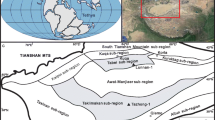Abstract
The presence of inhomogeneous sedimentation is acknowledged as being an important problem in palaeolimnological studies. Sediment records can be disturbed by erosional and redepositional events, which redeposit microfossils within a basin and may then lead to misinterpretations of fossil diatom assemblages. This study uses a combination of sedimentological tools, magnetic susceptibility measurements and high-resolution diatom analysis to show that a sediment core, BAIK80, taken in 345 m water depth from a shoulder region in the North Basin of Lake Baikal, is free of disturbances. Our results confirm that the sediment record is consistent and continuous for the uppermost sediment. Consequently, the fossil diatom data can be used to establish a continuous record of past climate variability over approximately the past 1300 years. Distinct changes occur in downcore abundances of endemic taxa Aulacoseira baicalensis and Cyclotella minuta, and principal components analysis (PCA) indicates a gradual transformation of taxa over the past 1300 years. These changes are likely to be related to climate, although definite links still have to be established.
Similar content being viewed by others
Author information
Authors and Affiliations
Additional information
Received: 15 December 1998 / Accepted: 13 September 1999
Rights and permissions
About this article
Cite this article
Bangs, M., Battarbee, R., Flower, R. et al. Climate change in Lake Baikal: diatom evidence in an area of continuous sedimentation. Int Journ Earth Sciences 89, 251–259 (2000). https://doi.org/10.1007/s005319900063
Issue Date:
DOI: https://doi.org/10.1007/s005319900063




